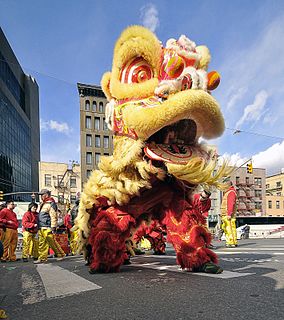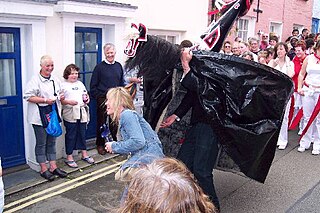 W
WThe Abbots Bromley Horn Dance is an English folk dance dating back to the Middle Ages. The dance takes place each year in Abbots Bromley, a village in Staffordshire, England. The modern version of the dance involves reindeer antlers, a hobby horse, Maid Marian, and a Fool.
 W
WThe Badalisc is a mythical creature of the Val Camonica, Italy, in the southern central Alps. The Badalisc is represented today as a creature with a big head covered with a goat skin, two small horns, a huge mouth and glowing eyes.
 W
WThe Busójárás is an annual celebration of the Šokci living in the town of Mohács, Hungary, held at the end of the Carnival season ("Farsang"), ending the day before Ash Wednesday. The celebration features Busós and includes folk music, masquerading, parades and dancing. Busójárás lasts six days, usually during February. It starts on a Thursday, followed by the Kisfarsang carnival on Friday, with the biggest celebration, Farsang vasárnap on the seventh Sunday before Easter Sunday; the celebration then ends with Farsangtemetés on the following Tuesday . These traditional festivities have been inscribed on the Representative List of the Intangible Cultural Heritage of Humanity of the UNESCO in 2009.
 W
WA deer dance is any of the world's folk dances performed by people dressed as deer.
 W
WThe Dorset Ooser is a wooden head that featured in the 19th-century folk culture of Melbury Osmond, a village in the southwestern English county of Dorset. The head was hollow, thus perhaps serving as a mask, and included a humanoid face with horns, a beard, and a hinged jaw which allowed the mouth to open and close. Although sometimes used to scare people during practical jokes, its main recorded purpose was as part of a local variant of the charivari custom known as "skimity riding" or "rough music", in which it was used to humiliate those who were deemed to have behaved in an immoral manner.
 W
WDragon dance is a form of traditional dance and performance in Chinese culture. Like the lion dance, it is most often seen in festive celebrations. The dance is performed by a team of experienced dancers who manipulate a long flexible figure of a dragon using poles positioned at regular intervals along the length of the dragon. The dance team simulates the imagined movements of this river spirit in a sinuous, undulating manner.
 W
WGolowan is the Cornish language word for the Midsummer celebrations in Cornwall, UK; widespread prior to the late 19th century and most popular in the Penwith area and in particular Penzance and Newlyn. The celebrations were centred on the lighting of bonfires and fireworks and the performance of associated rituals. The midsummer bonfire ceremonies were revived at St Ives in 1929 by the Old Cornwall Society and since then spread to other societies across Cornwall, as far as Kit Hill near Callington. Since 1991 the Golowan festival in Penzance has revived many of these ancient customs and has grown to become a major arts and culture festival; its central event 'Mazey Day' now attracts tens of thousands of people to the Penzance area in late June.
 W
WGuise dancing is a form of community mumming practiced during the twelve days of Christmastide, that is, between Christmas Day and Twelfth Night in West Cornwall, England, UK. Today, guise dancing has been appropriated for feast days at other times of the year.
 W
WThe term "hobby horse" is used, principally by folklorists, to refer to the costumed characters that feature in some traditional seasonal customs, processions and similar observances around the world. They are particularly associated with May Day celebrations, mummers' plays and the Morris dance in England.
 W
WHoodening, also spelled hodening and oodening, is a folk custom found in Kent, a county in south-eastern England. The tradition entails the use of a wooden hobby horse known as a hooden horse that is mounted on a pole and carried by an individual hidden under a sackcloth. Originally, the tradition was restricted to the area of East Kent, although in the twentieth century it spread into neighbouring West Kent. It represents a regional variation of a "hooded animal" tradition that appears in various forms throughout the British Isles.
 W
WKitakami Michinoku Traditional Dance Festival is a summer festival held in Kitakami, Iwate, Japan, where Devils Sword (鬼剣舞), Deer (鹿踊), Tiger and other traditional dances of Michinoku, Japan's northeast region, are performed. A recent program of this festival included: Bon dance on the first day, the parade of the traditional dances on the second, and the Fireworks display over the Kitakami River on the third day.
 W
WKukeri are elaborately costumed Bulgarian men, who perform traditional rituals intended to scare away evil spirits. This Bulgarian tradition has been practiced since Thracian times and is of a Thracian origin.
 W
WLion dance is a form of traditional dance in Chinese culture and other Asian countries in which performers mimic a lion's movements in a lion costume to bring good luck and fortune. The lion dance is usually performed during the Chinese New Year and other Chinese traditional, cultural and religious festivals. It may also be performed at important occasions such as business opening events, special celebrations or wedding ceremonies, or may be used to honour special guests by the Chinese communities.
 W
WThe Mari Lwyd is a wassailing folk custom found in South Wales. The tradition entails the use of an eponymous hobby horse which is made from a horse's skull mounted on a pole and carried by an individual hidden under a sackcloth.
 W
WIn the coastal town of Minehead, located in the southwest English county of Somerset, there is a folk custom on May Day entailing the parading of a brightly decorated hobby horse around the locality.
 W
WThe 'Obby 'Oss festival is a folk custom that takes place each May Day in Padstow, a coastal town in North Cornwall. It involves two separate processions making their way around the town, each containing an eponymous hobby horse known as the 'Obby 'Oss.
 W
WOld Horse was a folk custom found in an area of north-eastern England. Geographically, the custom was found in Nottinghamshire, Derbyshire, and part of Yorkshire. The tradition entails the use of a hobby horse that is mounted on a pole and carried by an individual hidden under a sackcloth. It represents a regional variation of a "hooded animal" tradition that appears in various forms throughout the British Isles. In geographical location and style it displays strong similarities with the Old Tup custom, but in the latter the hobby horses was presented as a goat rather than a horse.
 W
WOld Tup, sometimes termed the Derby Tup or the Derby Ram, is a folk custom found in an area of the East Midlands of England. Geographically, the custom was found on the borders of Derbyshire and Yorkshire and stretched into part of Nottinghamshire. The tradition entails the use of a hobby horse with a goat's head that is mounted on a pole and carried by an individual hidden under a sackcloth. It represents a regional variation of a "hooded animal" tradition that appears in various forms throughout the British Isles. In geographical location and style it displays strong similarities with the Old Horse custom, but in the latter the hobby horse was presented as a horse rather than a goat.
 W
WA pantomime horse is a theatrical representation of a horse or other quadruped by two actors in a single costume who cooperate and synchronize their movements. One actor plays the front end, including the horse's head and its front legs, in a more-or-less upright posture and with a reasonable field of view afforded by eye holes in the horse's head. The other actor, playing the rear end of the animal, must bend at the waist so that his torso is horizontal like that of a horse and put his arms around the waist of the first actor. He can see little, although there are normally eye holes in the bottom part of the horse's torso to enable him to see where he is putting his feet and to enable him to breathe.
 W
WPerchtenlaufen is a folk custom found in the Tyrol region of central Europe. Occurring on set occasions, the ceremony involves two groups of locals fighting against one another using wooden canes and sticks. Both groups are masked, one as 'beautiful' and the other as 'ugly' Perchte.
 W
WA straw bear is a traditional character that appears in carnival processions or as a separate seasonal custom in parts of Germany, mainly at Shrovetide but sometimes at Candlemas or Christmas Eve.
 W
WTiger dance is a traditional performing art in which persons wearing tiger costumes dance by themselves or with others.
 W
WWhittlesey is an English town 6 miles (10 km) east of Peterborough in the Fenland district of Cambridgeshire. Its population was 16,058 at the 2011 Census, when the neighbouring villages of Coates, Eastrea, Pondersbridge and Turves were included.
 W
WZvončari ("bellmen") is the characteristic folk custom maintained in the region around Rijeka, Croatia. It was added to UNESCO's Representative List of the Intangible Cultural Heritage of Humanity in 2009.